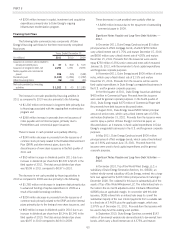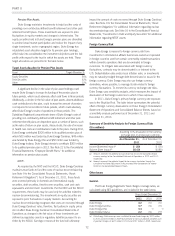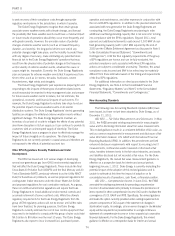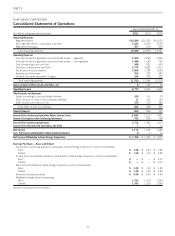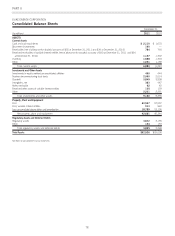Duke Energy 2011 Annual Report Download - page 93
Download and view the complete annual report
Please find page 93 of the 2011 Duke Energy annual report below. You can navigate through the pages in the report by either clicking on the pages listed below, or by using the keyword search tool below to find specific information within the annual report.
PART II
Global Climate Change and Other EPA Regulations Under
Development.
The EPA publishes an inventory of man-made U.S. greenhouse
gas (GHG) emissions annually. In 2009, the most recent year
reported, carbon dioxide (CO2), a byproduct of all sources of
combustion, accounted for approximately 83% of total U.S. GHG
emissions. The Duke Energy Registrants’ GHG emissions consist
primarily of CO2and most come from its fleet of coal-fired power
plants in the U.S. In 2011, the Duke Energy Registrants’ U.S. power
plants emitted approximately 91 million tons of CO2.TheCO
2
emissions from Duke Energy’s international electric operations were
approximately 2.3 million tons. The Duke Energy Registrants’ future
CO2emissions will be influenced by variables including new
regulations, economic conditions that affect electricity demand, and
the Duke Energy Registrants’ decisions regarding generation
technologies deployed to meet customer electricity needs.
The Duke Energy Registrants believe it is highly unlikely that
legislation mandating reductions in GHG emissions will be passed by
the 112th Congress which ends at the end of 2012. Beyond 2012
the prospects for enactment of any federal legislation mandating
reductions in GHG emissions is highly uncertain. Given the high
degree of uncertainty surrounding potential future mandatory federal
GHG emission reduction l legislation, management cannot predict if
or when such legislation might be enacted, what the requirements of
any potential legislation might be, or the potential impact it might
have on the Duke Energy Registrants. Among the outcomes of the
17th Conference of the Parties of the United Nations Framework
Convention on Climate Change was a decision by the participating
countries to adopt a universal legal agreement no later than 2015 to
be put into place by 2020. The conference, which was held in
Durban, South Africa, again revealed significant differences of opinion
amongst nations, particularly between developed and developing
economies, but there was agreement to continue the search for
common ground. The non-binding pledge to reach agreement by
2015 was reached only after delegates agreed to extend the
conference an extra day. The international climate change negotiating
process is highly uncertain and management cannot predict what the
outcome might be or the potential impact it might have on the Duke
Energy Registrants.
On December 7, 2009, the EPA finalized an Endangerment
Finding for greenhouse gases under the Clean Air Act (CAA). The
Endangerment Finding did not impose any regulatory requirements
on the electric utility industry, but it was a necessary prerequisite for
the EPA to be able to finalize several subsequent GHG rules. A
subsequent EPA regulation of GHGs from mobile sources issued in
2010 resulted in GHGs being pollutants subject to regulation under
the CAA, thereby subjecting newly constructed and modified
stationary sources to the CAA’s Prevention of Significant Deterioration
(PSD) permitting program for increases in GHGs. Without any
changes, the CAA requirements would have subjected tens of
thousands of additional stationary sources of GHG emissions to PSD
permitting requirements. To avoid this result, the EPA issued the
Tailoring Rule on June 3, 2010. Under the Tailoring Rule, new
major stationary sources of GHGs and existing major stationary
sources of GHGs that undertake a modification that will result in a net
GHG emissions increase of at least 75,000 tons per year are subject
to GHG permitting requirements under the PSD permitting program.
All of the Duke Energy Registrants’ existing coal-fired generating units
and several of its natural gas-fired generating units are major sources
of GHG emissions. The PSD permitting program requires sources that
trigger PSD permitting requirements for GHGs to perform a Best
Available Control Technology (BACT) analysis for GHG emissions to
determine what, if any, actions must be taken at the source to limit
its GHG emissions. In each of the states in which the Duke Energy
Registrants operates major stationary sources of GHG emissions, the
state is the permitting authority for the PSD program. This means that
the states will ultimately determine the BACT requirements that will
apply in the event a Duke Energy Registrant triggers PSD permitting
requirements for GHG emissions at any of its new or existing facilities.
Greenhouse gas PSD permitting requirements and the application
of BACT to limit GHG emissions do not apply to any existing source
that does not undertake a modification resulting in a net GHG
emissions increase of at least 75,000 tons per year. While the Duke
Energy Registrants do not anticipate taking actions that would trigger
the PSD permitting requirements for GHGs at any of its existing
generating facilities or facilities currently under construction, if it were to
do so, management does not believe that it would have a material
impact on the Duke Energy Registrants’ future results of operations.
Numerous entities have filed petitions with the D.C. Circuit
Court of Appeals for review of EPA’s Endangerment Finding and
Tailoring Rule. Management cannot predict the outcome of the
litigation. Oral arguments in the case are scheduled for February 28
and 29, 2012. A decision in the case is likely in the second or third
quarter of 2012. On March 2, 2011, the EPA entered into a
settlement agreement requiring it to propose by July 26, 2011, (this
date was later revised to September 30, 2011) and finalize by
May 26, 2012, a rule to establish GHG emission standards (New
Source Performance Standards, or NSPS) for new fossil-fueled electric
generating units and existing fossil-fueled electric generating units that
undertake a major modification. The settlement agreement also
required the EPA to issue on the same schedule emission guidelines
for states for their use in developing plans for reducing GHG
emissions at existing fossil-fueled electric generating units that do not
undertake a major modification. Recent developments indicate that
the EPA will first propose a NSPS rule that covers new and possibly
modified sources, in early 2012. Under the NSPS program, the rule
takes effect upon proposal. There is no indication when the EPA
might issue proposed emission guidelines for existing sources. The
outcome of these pending EPA regulatory actions is uncertain and
management cannot determine at this time if they will have a
material impact on the Duke Energy Registrants’ future results of
operations or cash flows.
The Duke Energy Registrants do not anticipate any of the states
in which it currently operates fossil-fueled electric generating units to
take action absent a federal requirement to mandate reductions in
GHG emissions from these facilities.
The Duke Energy Registrants are taking actions today that will
result in reduced GHG emissions over time. These actions will lower
the Duke Energy Registrants’ exposure to any future mandatory GHG
emission reduction requirements, whether a result of federal
legislation or EPA regulation. Under any future scenario involving
mandatory GHG limitations, the Duke Energy Registrants would plan
73


